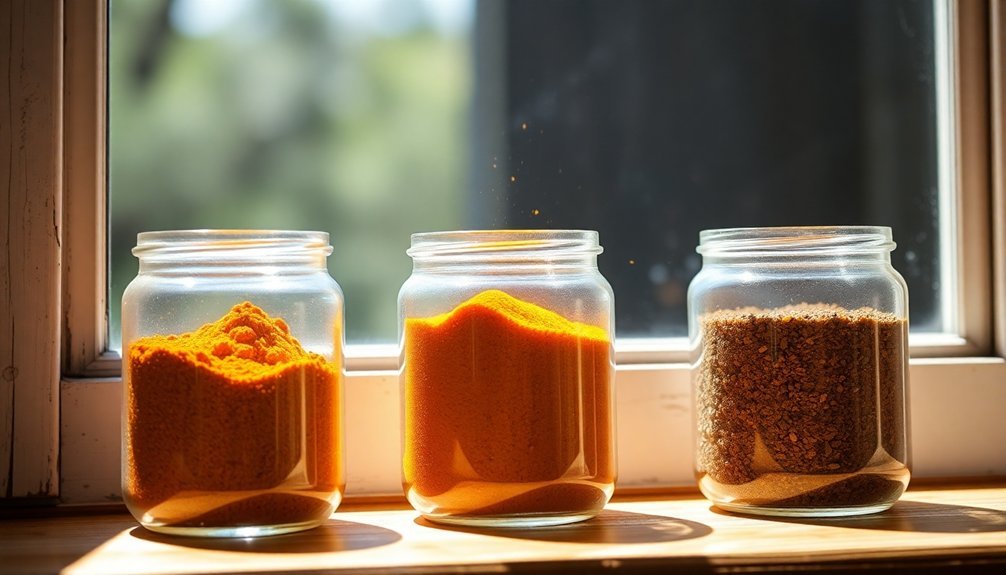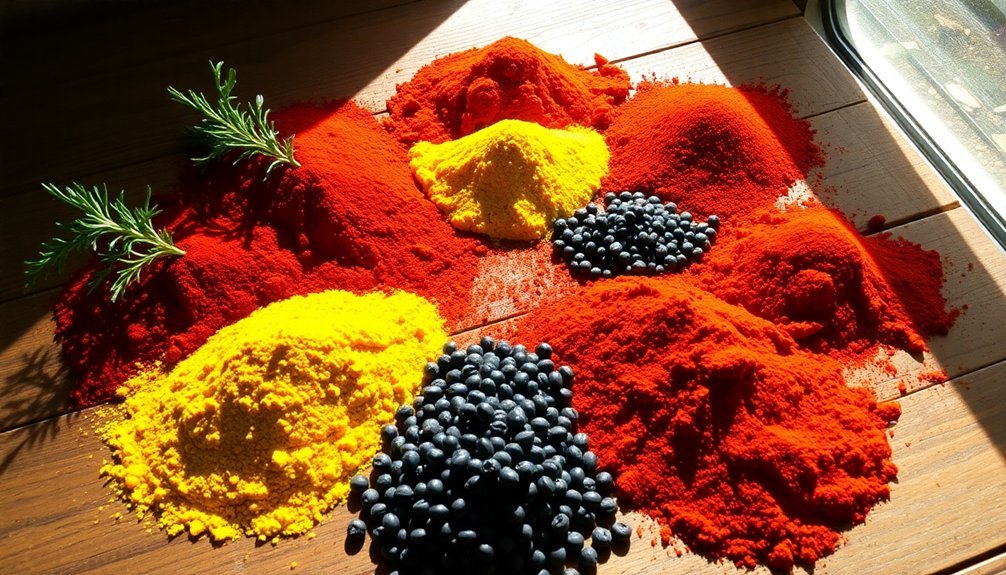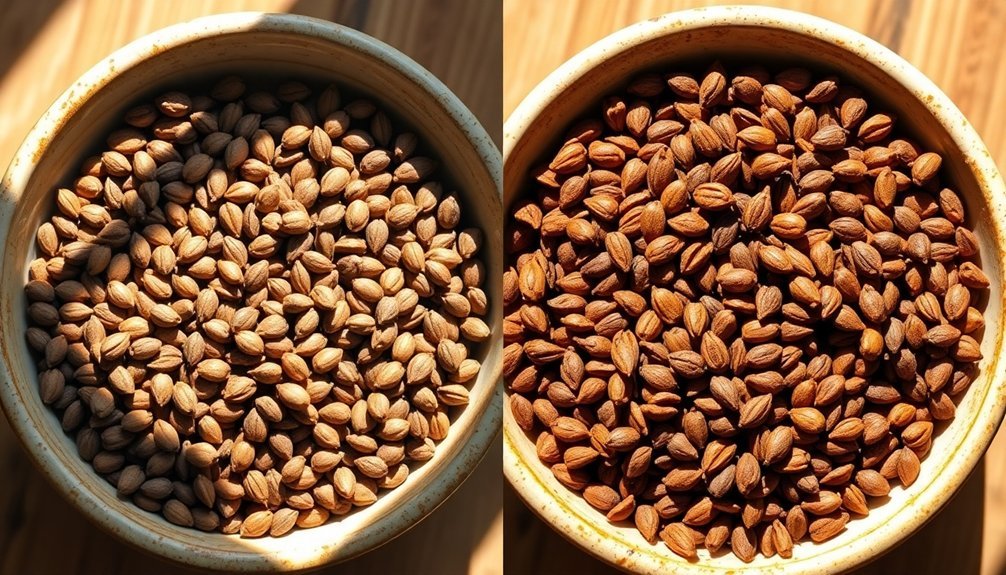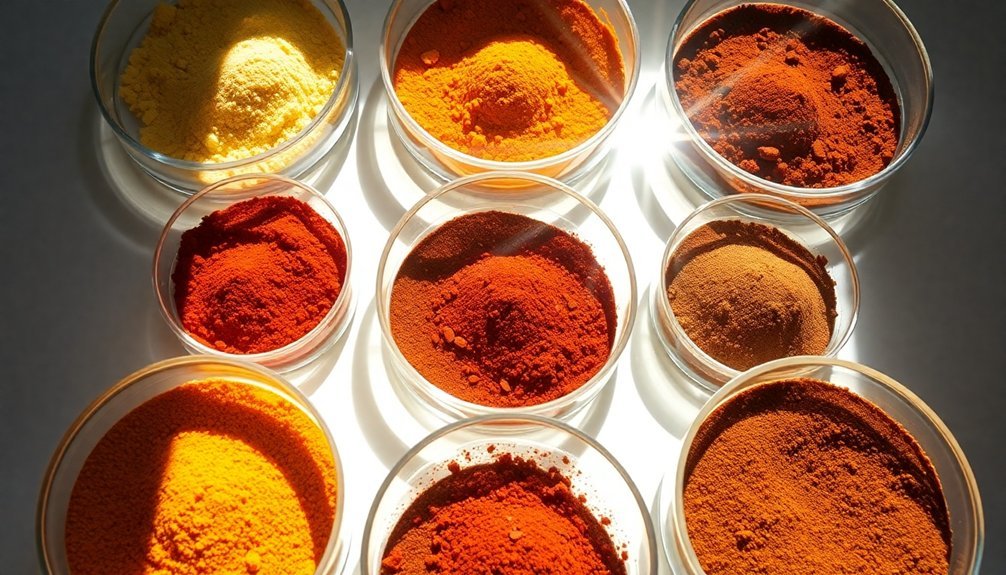When you cook with solar heat, your spices undergo fascinating transformations. Whole spices like cumin, coriander, and mustard seeds release their essential oils gradually, developing deeper flavors over time. You'll find that ground spices need careful monitoring since they can become bitter if overheated. Heat-tolerant aromatics bloom beautifully in oil under the sun's rays, making them perfect for dishes like tandoori chicken and spiced rice. Your cooking times may vary with sunlight intensity and weather conditions, so it's worth adjusting your seasonings accordingly. The sun's unique heating properties can reveal flavors you won't experience with conventional cooking methods.
Understanding Heat and Spice Behavior

When you expose spices to heat, their essential oils rise to the surface, releasing deeper and more complex flavors in your dishes. This process helps smooth out bitter notes while adding a pleasant toasted taste, particularly in spices like dried chilis, star anise, and peppercorns.
You'll find that heating also changes the texture of certain spices, making them easier to work with. Caramelization enhances taste when spices are properly heated. Coriander and mustard seeds become more grindable, allowing you to achieve a finer consistency that'll distribute more evenly throughout your food.
While whole spices respond well to heat, you'll need to be careful with pre-ground varieties as they can burn quickly. The key is monitoring the temperature and aroma carefully – you'll typically need just two to three minutes of heating to reveal these enhanced flavors and improved textures.
Common Spices for Solar Cooking
Your spice choices for solar cooking should account for how whole spices release flavors differently than ground versions, with whole varieties often performing better in the gentler heat of a solar cooker.
You'll find heat-tolerant aromatic seeds like cumin and coriander work especially well, as they've historically been used in sun-exposed cooking methods. Using cast-iron cookware enhances the development of spice flavors during the slow cooking process.
Traditional sun-dried spices, such as cayenne and curry blends, naturally complement solar cooking since they're already adapted to intense sunlight conditions.
Whole Versus Ground Spices
Understanding the difference between whole and ground spices is essential for successful solar cooking. Since solar cooking often involves longer cooking times, your choice between whole and ground spices can greatly impact your dish's final flavor. Whole spices can be stored in airtight containers to maintain their potency for solar cooking.
- Whole spices retain their flavor longer and release it gradually, making them ideal for solar cooking's extended heating periods.
- Ground spices release their flavors more quickly but can become bitter if exposed to heat for too long.
- When converting from whole to ground spices, use about ¾ teaspoon of ground for every 1 teaspoon of whole spice.
- Toast your whole spices before adding them to solar-cooked dishes to enhance their flavors.
Remember to add whole spices early in the cooking process, allowing their flavors to develop fully as your solar cooker works its magic.
Heat-Tolerant Aromatic Seeds
Heat-tolerant aromatic seeds form the backbone of successful solar cooking, as they maintain their integrity and release complex flavors during long, gentle heating periods.
You'll find that cumin, mustard seeds, and coriander are particularly well-suited for solar cooking when added early, as they bloom beautifully in oil to release their essential oils and aromas.
When you're working with these seeds in your solar cooker, start by adding them to hot oil at the beginning of your cooking process. Similar to heat-tolerant varieties of produce, these spices can withstand extended exposure to high temperatures without losing their qualities.
This technique works especially well in dishes like solar-cooked Tandoori chicken or basmati rice preparations.
If you're using whole spices, they'll hold up better than their ground counterparts during the extended cooking times that solar cooking requires, maintaining their robust flavors throughout the process.
Traditional Sun-Dried Varieties
While green chilies form the cornerstone of traditional sun-dried spices, their transformation through solar drying creates a uniquely versatile ingredient for solar cooking.
You'll find these sun-dried varieties, known as voorumirapakaayalu in Telugu or mor molagai in Tamil, offer a perfect balance of sour, salty, and spicy flavors without overwhelming heat.
To create these flavorful additions to your solar-cooked meals:
- Split fresh green chilies vertically on two sides
- Soak them in thick buttermilk and salt for 3 days
- Sun-dry until they develop a beige, withered appearance
- Store in airtight containers for preservation
When you're ready to use them, deep-fry until brown and crispy.
They're excellent accompaniments to dal, rice, or curry dishes, and they'll retain more nutrients thanks to solar cooking's gentler heating process.
Temperature Control and Flavor Release

As spices encounter varying temperatures, their complex flavor compounds undergo remarkable transformations that can either enhance or diminish their potency.
You'll notice how heat draws essential oils to the surface of spices, creating more intense flavors while smoothing out bitter notes.
When you're working with dried chilis, star anise, or peppercorns, heat exposure will release more of their essential oils.
You can even use solar power's thermal-trap effects to achieve ideal temperatures for spice preparation. This technology can reach up to 1,000°C, though you'll want much lower temperatures for most culinary applications.
For delicate spices like ginger and cardamom, you'll need careful temperature control to preserve their unique profiles while maximizing flavor release.
The key is finding the sweet spot where heat enhances rather than degrades these precious compounds.
Adapting Traditional Spice Measurements
When adapting your favorite recipes for sun-powered cooking, you'll need to adjust traditional spice measurements to account for the concentrated flavors that develop during longer cooking times.
You can start by using about 25% less of your usual spice amounts, as solar cooking's steady heat and moisture retention intensify seasoning effects.
Remember that the reduced liquid evaporation in solar cooking means your spices won't dissipate as quickly, so it's better to start conservative and add more if needed.
Adjusting Heat-Based Spice Ratios
Traditional recipes often need significant adjustments when adapting them for solar cooking, particularly in how spices and herbs are measured and timed.
You'll need to take into account how different seasonings react to prolonged sun exposure and lower temperatures compared to conventional cooking methods.
- Reduce heat-sensitive herbs like basil and oregano by 25%, adding them toward the end of cooking to prevent bitterness.
- Maintain regular amounts of stable spices like cumin, cloves, and nutmeg, as they hold up well in solar heat.
- Intensify flavors gradually by using pre-mixed spice blends or Ramen seasoning packets.
- Balance your dish with acid (lemon, tomatoes) and umami elements (soy sauce, Worcestershire).
Keep a cooking log to track successful spice combinations, as you'll find solar cooking creates unique flavor profiles that differ from traditional methods.
Converting Solar Cooking Times
Successfully converting recipes for solar cooking requires a thorough understanding of timing adjustments and spice measurements.
You'll need to double your usual cooking times and adjust your seasonings accordingly, as spices release their flavors more slowly in solar cookers.
When adapting your recipes, reduce the amount of liquid you'd normally use, since solar cooking retains more moisture. Your spices will have extra time to develop and meld together, which can intensify their flavors. For dishes like chili, you'll find this works to your advantage as the extended cooking time allows spices to break down more completely.
Remember that sunlight intensity affects your cooking time. On cloudy days, you might need to increase your cooking duration further and consider using heat-retention methods like baking bags to maintain consistent temperatures.
Moisture Impact on Portions
Managing moisture content stands at the heart of adapting spice measurements for solar cooking. You'll need to adjust your traditional spice portions since sun-powered heat affects moisture levels differently than conventional cooking methods. Proper moisture balance guarantees your spices maintain their flavor, aroma, and texture while preventing contamination.
When adapting your spice measurements for solar cooking, consider these vital factors:
- Monitor your spices' texture – clumping indicates too much moisture, while a powdery consistency means it's too dry.
- Adjust portions based on your local climate and storage conditions.
- Recalibrate measurements to maintain flavor potency, as moisture levels affect aromatic compounds.
- Choose appropriate packaging that protects against unwanted moisture absorption.
Remember to continuously check moisture content, as it directly impacts the accuracy of your spice measurements and overall dish quality.
Timing Your Solar Spice Additions

When planning your solar installation timeline, you'll find that Spice Solar's integrated racking system cuts the usual installation time in half.
You won't need special tools or separate racking components since everything's built right into the module frames.
You can schedule your installation with confidence, knowing the system works on all U.S. roof types and weather conditions.
The streamlined design requires 25% fewer roof mounts than standard systems, and you'll only need one grounding point per array.
Since everything ships on a single pallet, you can coordinate delivery more efficiently.
The UL-certified system handles up to 45 psf in both positive and negative loads, so you won't need to worry about timing around seasonal weather changes.
The direct-attach method eliminates rail splicing and sawing, making your installation straightforward regardless of when you schedule it.
Weather Effects on Spice Intensity
The interplay between weather and spice intensity creates fascinating effects on how you'll experience heat in your dishes. Understanding these relationships can help you adjust your spice levels for ideal flavor impact, whether you're cooking on a scorching summer day or a chilly winter evening.
- Hot temperatures will amplify the burning sensation of capsaicin, making your spicy dishes feel more intense.
- Cold temperatures can temporarily numb your taste buds, reducing the perceived spiciness of your food.
- You'll find that liquid-based spicy sauces pack more heat than paste-type sauces, regardless of temperature.
- If you're seeking a cooling effect, try incorporating spices like fennel, mint, cardamom, or cumin into your dishes.
Remember that spiciness isn't actually a flavor but a sensation triggered by compounds interacting with your pain receptors, so temperature can greatly influence your experience.
Solar Versus Conventional Seasoning

Modern spice drying stands at a crossroads between traditional methods and solar innovation. If you're considering solar drying for your spices, you'll find it offers distinct advantages over conventional methods.
While traditional drying might be faster, solar systems preserve more of your spices' natural qualities. You'll notice better color retention, enhanced flavor preservation, and more consistent nutrient content in solar-dried spices.
Though you'll face higher upfront costs for solar equipment, you'll save money long-term by eliminating fuel and electricity expenses.
Solar dryers, which can reach temperatures up to 500°F at focal points, effectively reduce moisture content while requiring less maintenance than conventional systems.
Whether you're operating a small garden setup or a commercial facility, you'll benefit from solar drying's scalability and environmental advantages.
Best Practices for Spicy Success
Successfully working with spicy ingredients demands proper handling and thoughtful preparation techniques. When cooking with sun-powered heat, you'll need to be especially mindful of how spices and peppers interact with varying temperatures throughout the day.
- Always wear latex gloves when handling hot peppers and avoid touching your face – solar cooking's longer duration means you'll be handling ingredients multiple times.
- Bloom your spices in oil before adding them to your solar cooker to release maximum flavor.
- Keep dairy products like yogurt or milk nearby to neutralize heat if needed.
- Start with milder peppers and gradually increase heat levels as you learn how solar cooking affects spice intensity.
Remember to test heat levels before adding ingredients, and don't hesitate to use acidic elements like citrus or tomatoes to balance the flavors in your sun-powered dishes.
Frequently Asked Questions
Can Solar Cooking Enhance the Medicinal Properties of Certain Spices?
Yes, you'll find that solar cooking enhances spices' medicinal properties through gentle heating, which activates beneficial compounds and improves their bioavailability. It preserves nutrients while making them more effective for your health.
Do Spices Affect the Thermal Absorption Rate of Solar Cookers?
No, your spices won't affect your solar cooker's thermal absorption rate. While they can influence cooking time based on the dish's complexity, they don't change how efficiently your cooker captures or retains solar heat.
Which Spice Combinations Work Best for Overnight Solar Food Storage?
You'll get the best overnight storage results by combining granulated garlic with cumin and bay leaves. Adding thyme and black pepper helps preserve flavors, while paprika and oregano maintain food's seasoning through morning.
How Do Different Colored Spices Respond to Direct Sunlight Exposure?
You'll notice red spices like paprika and cayenne bleach faster than green ones when exposed to direct sunlight. Keep your spices protected, as they'll lose color intensity when left in bright light.
Can Solar-Cooked Spices Maintain Their Potency Longer Than Conventionally Heated Ones?
You'll find that solar-cooked spices can retain more potency due to lower, steadier temperatures. However, you must protect them from direct sunlight and excess moisture to maintain their strength longer than conventional cooking.
In Summary
Your approach to solar cooking with spices needs careful adjustment. You'll find that volatile oils in spices like cumin, coriander, and paprika release differently under solar heat. Remember to reduce your usual spice amounts by about 25% and add them later in the cooking process. Keep monitoring weather conditions, as cloud cover can affect how intensely your spices develop. With practice, you'll master this eco-friendly cooking method.





Leave a Reply